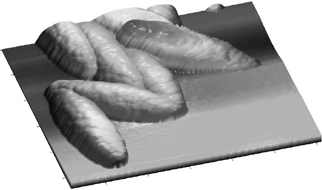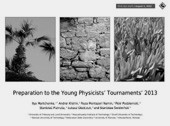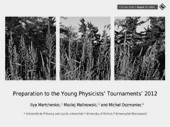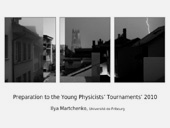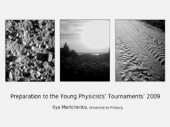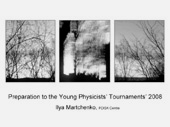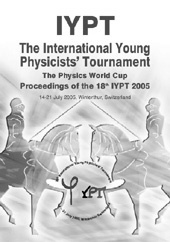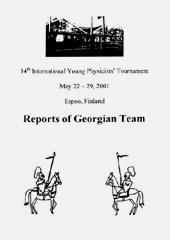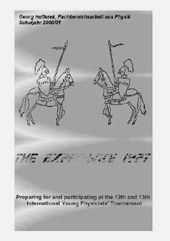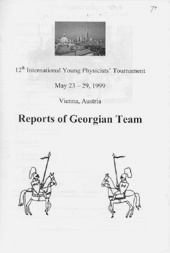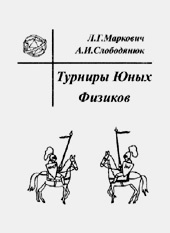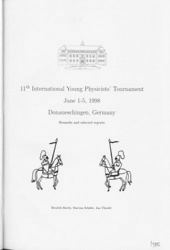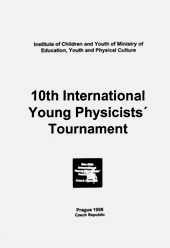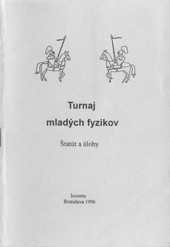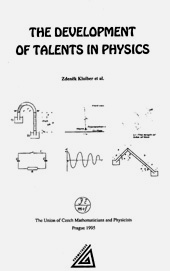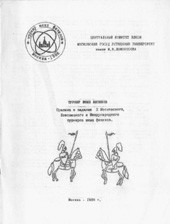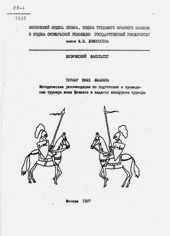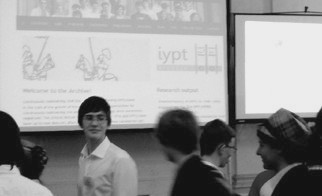Efforts pay off: Front cover

Is it possible to predict the dynamics of non-spherical colloids from their dimensions, without having to invoke any adjustable free parameter? Is it possible to establish a tailor-made monodisperse model system? With depolarized light scattering, we test a new method where hydrodynamic models are combined with a routine of statistical weighting. The front cover of The Journal of Physical Chemistry B illustrates the link between mobility of cutting-edge anisotropic nanosystems and simple hydrodynamic theories developed decades ago. (J. Phys. Chem. B 115, 49, 2011.)
First day draft: Reference kit 2013
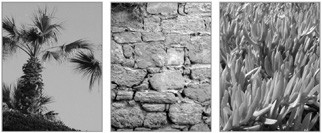
„Außerdem sei auf Ilyas Sammlung zu den Problems hingewiesen“. „Doporučujeme nahlédnout do materiálů, kde jsou k dispozici podrobnější informace k jednotlivým úlohám i návody k jejich řešení“. „Полезни коментари и литература за задачите“. ”För den som vill finns också möjlighet att få tillgång till referenser för relevant forskning kring uppgifterna”. « Inspirez vous des sujets proposés aux IYPT et des conseils et bibliographie. » «Материал исключительной важности: текст о том, как готовиться к ТЮФу, с подробными коментариями ко всем задачам этого года! Всем читать! Английского не бояться! Меня этот материал поразил очень сильно». „Dobrá zbierka odkazov na literatúru, súbor otázok k úlohám, ktoré smerujú k pochopeniu podstaty problému“. „Viele Ideen für die Bearbeitung der Probleme findet man im ausführlichen Reference Kit“. «Задача материалов состоит в том, чтобы стимулировать вашу самостоятельную исследовательскую работу, соотнося её с тем, что уже было сделано в этой области ранее другими людьми, поднимаясь до тех стандартов, которые приняты в современной науке и избегая деятельности по „изобретению колеса”».
IYPT Proceedings 2010-2011
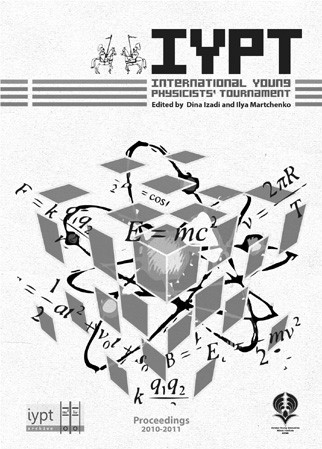
Get the first ever IYPT Proceedings book where each submission underwent rigorous peer review (June 17, 2012.)
Fast, simple, and organized

To handle the growing inflow of slides and reports, the IYPT Archive launches its online submission manager, IYPT Solutions. We thus aim at creating a simple but efficient platform to facilitate future submissions and to improve the ease of exchanging and safekeeping visions and expertise. The platform, powered by PHP and MySQL, has been implemented by odpo, a small Kraków-based startup company. (September 4, 2011.)
IYPT Proceedings 2011, 2010
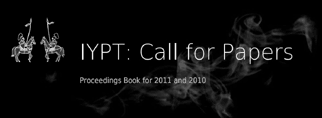
Articles based on the IYPT problems are actively encouraged, along with reports of general interest for the IYPT community, for physics teachers and for researchers in physics education.
All contributions will be indexed in the IYPT Archive upon submission. An extensive selection and rigorous review will be then carried out by the editorial board, prior to the publication. Any supplementary materials (slides, videos, extra figures) are welcome and will be indexed as online supporting information.
Interim deadline: November 10, 2011. Appx. length: 5 pages. Format and layout: MS Word template available online. Color: gray scale graphics only. The submissions should be emailed to ilya.martchenko@unifr.ch. (August 29, 2011.)
IYPT Archive online on May 5, 2011
IYPT 2012: Reference Kit, problems
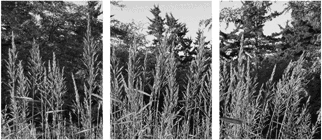
The Reference Kit for the 25th International Young Physicists’ Tournament 2012 is ready as a draft. The document, co-authored with Maciej Malinowski and Michał Oszmaniec, is released at the same day as the problems for the IYPT 2012. (August 13, 2011.)
The first day draft can be downloaded here; there is a supporting page. The earlier Kits are from 2011, 2010, 2009, and 2008.
A successful IYPT report means...
→ A novel research, not a survey or a compilation of known facts
→ A balance between experimental investigation and theoretical analysis
→ A comprehensible, logical and interesting presentation, not a detailed description of everything-you-have-performed-and-thought-about
→ A clear understanding of the validity of your experiments, and how exactly you analyzed the obtained data
→ A clear understanding of what physical model is used, and why it is considered appropriate
→ A clear understanding of what your theory relies upon, and in what limits it may be applied
→ Comparison of your theory with your experiments
→ Clear conclusions and clear answers to the raised questions, especially those in the task
→ A clear understanding of what is your novel contribution, in comparison to previous studies
→ Solid knowledge of relevant physics
→ Proofread nice-looking slides
→ An unexpected trick, such as a demonstration in situ, will always be a plus
(Draft 2011 IYPT Reference kit, December 14, 2010)
Knowing more and doing novel research?
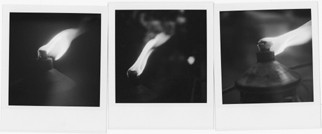
The reference kit for the 24th IYPT 2011 is ready as a working draft. The earlier kits are available from 2010, 2009, and 2008.
The kit brings together some common, openly accessible knowledge about the physics behind the IYPT problems. It is expected to stimulate, not to limit creativity (like reading science journals in a lab is stimulating, not limiting research.) An early exposure to the culture of scientific citations, and contrasting own contribution from earlier results, are assumed to be helpful experiences.
Even if linked from iypt.org, the kit is not an official release of the IYPT, and should under no circumstances be considered as a collection of “instructions” for whatever competition. Serious conclusions will be drawn, up to discontinuing the project in its current form, if systematic misuse of the kit is detected. Feedback about the drafts is warmly appreciated. (December 14, 2010.)
The updated final draft can be downloaded here; there is an information page.
Archive announced
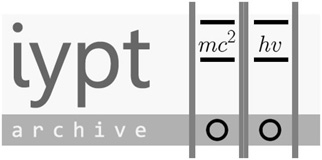
The IYPT Archive is a comprehensive collection of digitized sources unveiling the factual details and highlights in the history of International Young Physicists’ Tournaments and the Soviet-based YPTs.
The project is aimed at providing a coherent record of problems, results, and regulations for the early years of the competition. The digital repository will make the original accounts, in over ten languages, catalogued and readily available for future use.
Starting from an early personal collection, the Archive continued to grow through systematic research in 2007–2010. Preliminarily reported in a newsletter in March 2010, and accredited by the IYPT’s Executive Committee in November 2010, it is now being reviewed and completed up to a beta version.
The information site for the IYPT Archive will be up and running in 2011. (November 28, 2010.)
Поколенье — без почвы...
Нами были изучены серые типичные среднесуглинистые почвы на лессовидных суглинках, расположенные на участке «Лес на Ворскле» заповедника Белогорье, представляющие собой разновозрастные погребенные почвы и их целинный аналог. Погребенные почвы перекрыты покатым насыпным валом различной мощности (до 80 см), возникшим в результате изучения корневой системы модельного дуба в 1937 и 1974 годах.Для всех разрезов в пределах 40-см гумусо-аккумулятивной толщи послойно (через 5 см) были отобраны почвенные образцы, из которых выделены препараты гуминовых кислот методом щелочного гидролиза (0.1 М NaOH), с последующей очисткой препаратов на бактериальном фильтре и осаждением серной кислотой. Зольность препаратов не превышала 3 %.
Элементный состав был определен на CHN-анализаторе. Структурные характеристики препаратов гуминовых кислот определялись методом твердофазной CPMAS 13С-ЯМР спектроскопии на базе Института высокомолекулярных соединений на приборе фирмы Bruker. Оптическая плотность щелочных растворов ГК для разных длин волн измерена на спектрофотометре Unico-1200. Измерены гидродинамические радиусы, Rh, и степень полидисперсности частиц методом динамического рассеяния света (фотонной корреляционной спектроскопии) на гониометре 3D (Фрибур, Швейцария), при угле рассеяния 90° и с последующей обработкой корреляционных функций методом кумулянтов.
(«Изменение свойств гуминовых кислот в погребенных почвах», соавт. Александр Рюмин, Ирина Кечайкина, 2011 г.)
Last call for applications
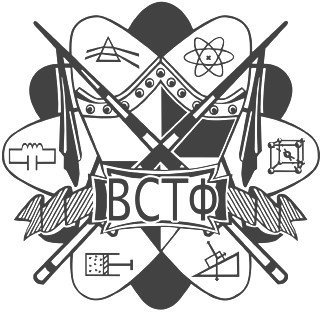
As of October 20, 2010, the organizers of the 3rd International Physicists’ Tournament for Undergraduate Students (currently branded as International Students Physicists’ Tournament) confirm a last call for registration, and kindly request all teams interested in participation, to urgently submit formal applications.
The event is to be held on March 17–23, 2011 at Moscow Institute of Physics and Technology, Russia, with a problem set jointly released on May 14, 2010. The Tournament, initiated in 2001 in Ukraine with a look-and-feel much common to the IYPT, became international in 2009. “We hope to attract as many teams as possible this year”, co-organizer Alexander Voloschuk commented in a private email, “So far, we are in contact with Denmark, the Netherlands, Slovakia, Croatia, Czech Republic, Georgia, and Kenya.”
Contact: Alexander Voloschuk, Moscow Inst. of Phys., Tech.
alexander.voloschuk@gmail.com, +7 926 308 5022
Gathering the IYPT history: You can help
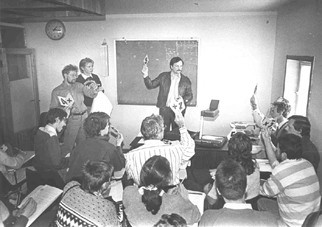
In the rush of the growth of the competition, the opportunities for maintaining the archives of the earliest YPTs and IYPTs were sometimes neglected.
The considerable interest that the today’s IYPT community has in the history of the competition has motivated the author and his colleagues to start investigating into the details of early IYPTs and Soviet-based YPTs and locating original documents, proceedings, problems, results, and information on participants. Quite naturally, many of these materials were not written in English or in Russian, but in local languages of participants. (Documents in over ten languages are now on the list.)
As of 2010, the priorities of the research are
1. to trace, proofread, and translate the problems for 1979–1987 and 1988–1993 into English,
2. to locate information on teams and results in 1979–1987 and 1988–1993, and
3. to clarify how the regulations and the typical research projects of the Tournament evolved since 1979.
Plans exist to catalogue the growing archives online. Any contributions from the readers on early IYPTs are warmly welcomed.
(From a newsletter in World Gifted, Vol. 29, No. 1, 13–15, 2010)
Мова наукова
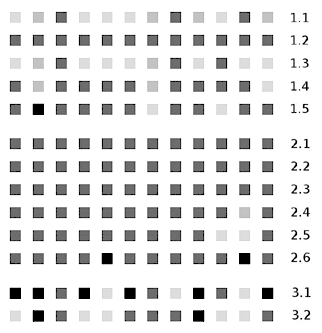
Міжнародне спілкування в науково-технічній спільноті стимулює учасників до пошуку працюючих комунікативних моделей. Значною мірою із цим пов’язана багатомовність реального спілкування в лабораторії або при листуванні.
Спостереження того, як фізики розуміють «малознайому» мову, і яка їх мотивація, дозволяють охарактеризувати цілі, успішність і мовні помилки спеціалістів-нефілологів.
Для аналізу проблеми розроблено вправи, серед якиx автентичні завдання з фізики. Завдання публікуються у журналі фізичного факультету Київського університету «Цитрус», у журналі фізичного факультету Санкт-Петербурзького університету «Спутник» та на білоруському сайті Mozg.by, всі з яких адресовані аудиторії, що раніше не вивчала обраної мови. Розв’язки збираються у середовищі Moodle на сайті Slavic.pl.
(«Інтерактивні завдання у навчанні навичкам науково-технічних слов’янських мов», співавтори Якуб Олех, Тимофій Николаєнко, січень, березень 2010 р.)
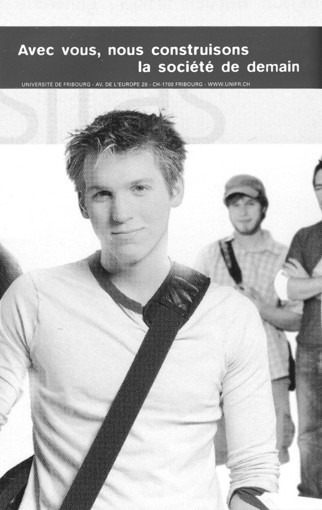
A personal hint...
perrin translational(10^9)*(293*1.38E-23)/(3*3.141592*0.001002*col(L)*sqrt(((col(p))^2)-1)/(col(p)*ln(col(p)+sqrt(((col(p))^2)-1))))
perrin rotational
(10^27)*(293*1.38E-23)/(((2/3)*3.141592*0.001002*((col(L))^3)*((((col(p))^4)-1)/((col(p))^4)))/((((2*((col(p))^2)-1)/(col(p)*sqrt(((col(p))^2)-1)))*ln(col(p)+sqrt(((col(p))^2)-1)))-1))
sausage translational
(10^9)*(293*1.38E-23)/((3*3.141592*0.001002*(col(L)))/(ln(col(p))+0.3863+(0.6863*(1/col(p)))-(0.06250*((1/col(p))^2))-(0.01042*((1/col(p))^3))-(0.000651*((1/col(p))^4))+(0.0005859*((1/col(p))^5))))
sausage rotational
(10^27)*(293*1.38E-23)/(((3.141592*0.001002*((col(L))^3))/3)*(ln(col(p))+(2*ln(2))-(11/6)+(((ln(2))/(ln(1+(col(p)))))*((1/3)-2*ln(2)+(11/6)-(13.04468-62.6084+174.0921-218.8356+140.26992-33.27076)))+(13.04468*((col(p))^(-0.25)))-(62.6084*((col(p))^(-0.5)))+(174.0921*((col(p))^(-0.75)))-(218.8356*((col(p))^(-1)))+(140.26992*((col(p))^(-1.25)))-(33.27076*((col(p))^(-1.5))))^(-1))
perrin oblate rotational
((10^27)*(293.1*1.38E-23))/(((2/3)*3.141592*((col(L))^3)*0.001002)*((1-((col(p))^4))/((col(p))^4))/(((1-2*((col(p))^2))/((col(p))*sqrt(1-((col(p))^2))))*(atan((sqrt(1-((col(p))^2)))/((col(p)))))+1))
Electrooptics, dynamics of denrimers
Acrylic polymers containing side dendrons of the third generation based on L-aspartic acid have been studied via the methods of molecular hydrodynamics, dynamic and static light-scattering, optics, and electrooptics.
There are marked differences in hydrodynamic and optical properties of the macromolecules under study and previously examined polymers with side dendrons of first and second generations.
In the range of degrees of polymerization from 10 to 40, these macromolecules possess an extremely low shape asymmetry. Experiments demonstrate the predominant orientation of end side dendrons along the main molecular chain.
In chloroform solutions, the orientation of macromolecules in hydrodynamic and electric fields occurs according to the large-scale mechanism. In dichloroacetic acid, the hydrodynamic dimensions of macromolecules decrease, an effect that is accompanied by an increase in the kinetic flexibility of polymer chains.
(Hydrodynamic, optical, and electrooptical properties of macromolecules of third-generation cylindrical dendrimers in chloroform and dichloroacetic acid, with Nikolai Tsvetkov, Larisa Andreeva, Sergei Filippov, Stanislav Bushin, Marina Bezrukova, Irina Strelina, Victoria Alyabyeva, Nina Girbasova, Alexander Bilibin. Polymer Science Series A, Vol. 52, No. 1, 11–22, 2010)
Nauka języka oraz ICQ
Komunikacja z rodzimym użytkownikiem języka (SLA from peers) może dawać dobrą motywację oraz być metodą stałego doskonalenia języka obcego.
Na bazie zapisu własnych rozmów, odbytych przy pomocy komunikatora ICQ w językach rosyjskim i polskim, autorzy dokonują analizy dynamiki stopnia poprawności wypowiedzi (pod względem ortograficznym, znaczeniowym i stylistycznym) w czasie.
Zidentyfikowano również typowe sytuacje niezrozumienia się, częstość ich występowania oraz sposoby rozwiązania.
Rozwój modeli językowych w taki sposób — prawie bez korzystania ze słowników i podręczników do gramatyki — rozpatrywany jest jako proces samoorganizacji językowej, stanowiący w ciągu ostatnich lat częsty przedmiot badań naukowych.
Otrzymane wyniki pokazują w jaki sposób korespondencja internetowa z osobą obcojęzyczną wpływa na poszerzenie umiejętności językowych.
(Korespondencja elektroniczna z rodzimym użytkownikiem języka jako strategia nauki, z Jakubem Olechem, styczeń 2009 r.)
Le français au labo
On en parle souvent : les articles dans les revues scientifiques sont presque tous en anglais, les réunions scientifiques se tiennent souvent en anglais. Le français perd-il alors des positions ? Quelle langue parle-t-on dans un laboratoire de recherche, quel y est l'avenir du français, faut-il protéger l'environnement linguistique dans le milieu scientifique ?
En tout cas, au laboratoire français on le parle !
Le français ne peut pas être la seule langue de travail : il sera toujours une langue parmi les autres. Voilà un exemple : en pratique, pour se sentir à l'aise, un physicien russe en France parle les trois langues à la fois ( tout en pensant à la physique ! )
L'anglais aide à apprendre le français : les étudiants russes comparent avec succès des éléments linguistiques des deux langues car, vus de loin ( langues slaves ), ces langues se ressemblent beaucoup.
Phonétique : on joue sur les contrastes ( « oubliez votre anglais ! » )
Lexique : une ressemblance presque totale du vocabulaire scientifique.
Grammaire : l'article, le système complexe mais logique des temps verbaux.
Erreurs : un traducteur technique russe maîtrisant le français comprend mieux les textes mal écrits en anglais par les non-anglophones car il est plus débrouillard en syntaxe.
En traduisant d'une seule langue on croit souvent qu'on traduit d'une langue. En apprenant des plusieurs langues et en traduisant de plusieurs langues on comprend que c'est déjà un nouveau type d'activité.
Le tout aide à mieux comprendre la notion de langue étrangère. Tout comme en géométrie : une ligne n'est qu'une ligne. Et deux lignes c'est beaucoup plus que deux fois une : c'est un espace bidimensionnel.
La proximité et la différence du français et de l'anglais permettent à l'étudiant d'elargir sa vision linguistique.
( « Le français et l'anglais dans la communication universitaire : une expérience de travail et d'enseignement », avec Dmitry Lisachenko, dans « Le français et l’anglais en contact dans les situations d’apprentissage : perspectives sociolinguistiques et didactiques », sous la direction de Gilles Forlot, coll. Espaces Discursifs, Editions l’Harmattan, 2007 )
Spallation Neutron Source SINQ
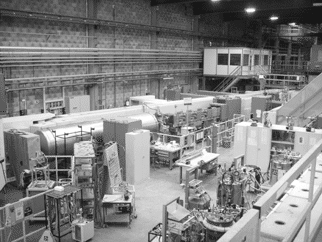
SANS-II is a 12 m small-angle scattering facility, operating with cold neutrons produced by the Swiss Spallation Neutron Source SINQ, Paul Scherrer Institute, Villigen.
SINQ neutons are liberated when a lead target is bombarded with a proton beam from particle accelerator. They are slowed down from 20 000 m/s to 2200 m/s in a moderator tank containing 6 m3 of heavy water D2O, and are further slowed down to 700 m/s in a separate volume of 0.02 m3, cooled with liquid hydrogen
SANS-II is equipped with 2D position-sensitive detector movable in a vacuum chamber in the range of 1...6 m from sample position, and has 128x128 0.5 cm pixels. Neutrons are guided from the source via the wavelength selector 4.5...20 Å, exchangeable attenuators and 1-m-long collimation sections with slits. They are then incident on the 7-position sample exchanger in a separate vacuum chamber.
Average neutron flux that is achieved at 4 m collimation and wavelength of 4.5 Å is 30 000 neutrons/s/cm2/mrad-1/mA.
250-nm-long hematite particles "scatter neutrons as hell" :-)
Незнакомый язык
Среди русскоязычных участников были школьники, живо интересующиеся физикой,
физики-студенты и физики зрелого возраста, люди гуманитарного склада ума, один
филолог. Была и болгарская школьница, которая переводила всё на болгарский.
Более 30 человек выполнили задания на французском, польском, сербском
(сербохорватском) и чешском языках (в общей сложности более 50 решений).
Рассмотрим следующий пример (на сербском языке):
Брзина у најширем смислу је промена неке величине у јединици времена.
Благодаря очевидному сходству с русским языком, всем было понятно из контекста,
что слово брзина означает скорость. Аналогичным образом распознавались слова
зрачење, зрак, jезгро, броj, талас.
Один из участников, Д.М., так прокомментировал свою стратегию перевода (весьма
успешную):
«Главное, что становится видно, — это возможность понимать, про что идёт
речь в тексте, в каждом предложении и фразе. Понятен общий смысл текста,
хотя раньше даже не подумал бы, что язык, который совсем не знаю, можно
настолько понимать. Из текста становятся понятны некоторые артикли или
частицы, используемые в речи, хотя так их не знал. Так было и с польским, и с
сербским, кажется, и сейчас с французским, а они же, вроде как, совсем
разные!»
Были названы следующие аспекты понимания текста:
1) важную роль играет мотивация
понять смысл и владение предметом;
2) то, что не очевидно сразу, можно восстановить
после некоторых размышлений.
Всеми признавался факт, что перевод выстраивался так, чтобы он имел физический
смысл.
Подтверждено экспериментально, что следующие задания на том же языке
воспринимаются быстрее и лучше, т.к. человек быстро приобретает необходимые
навыки и необходимый словарный запас.
(Из статьи «Понимание научно-технического текста на незнакомом языке: роль знаний по специальности, мотивации и сравнительного анализа», соавт. Д. А. Лисаченко, 2007 г.)
Never repeat
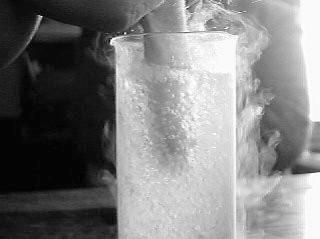
The Leidendrost effect with my index finder in liquid nitrogen at
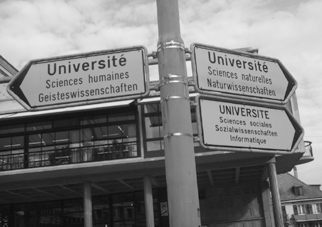
A physicist uses Wikipedia
It is discussed what benefits a physicist may gain in using Wikipedia, a multilingual online information repository written and edited collaboratively by volunteers, with over 2·106 articles in the English section and over 6·106 articles in other languages.
Cross-checking and verifiability. Science entries in Wikipedia aim to provide references to its sources, such as peer-reviewed magazines, often available online [1], [2]. In most cases, if one has found an article on a specific subject, he can expect to quickly proceed to relevant original sources. At least 3·104 science references even had proper bibliographic markup [3].
A quick reference. Definitions, formulas, numerical values (such as fundamental constants, densities, viscosities…) and external links are organized well and are likely to be found and, if needed, cross-checked rapidly.
Number of wikipedian physicists. A direct count through userboxes has shown that by October 2007 at least 172 physicists actively contributed to English Wikipedia, while at least 27 of them had PhD degrees. In the Russian Wikipedia, at least 42 physicists were active contributors, with at least 5 having PhD degrees.
References to Wikipedia. At least 150 articles in the Cornell University’s arXiv archive which now receives a major part of published physics papers, proposed Wikipedia articles for further reading.
Reliability of Wikipedia should be understood in a statistical sense. In 2005, Nature’s empirical research [2] has shown that the expected factual accuracy of science entries in Wikipedia is comparable to those of Encyclopeadia Britannica with respectfully 4 and 3 inaccuracies per article, in average. The quality of articles is steadily increasing after numerous edits and refinements.
Criticism. An entry in Wikipedia may be claimed incomplete or poorly structured. However, a physics article is often written by a physicist and addressed to physicists, thus unlikely being flawed, mistaken or vandalized.
A language assistant. Despite the dominance of the English language, physics remains a multilingual science. Thus, a physicist may always need a brief help in checking (or finding) a good translation for a term, a name or an abbreviation. Many examples [4] show that even a specialized bilingual dictionary cannot always provide an accurate reference for physical terminology (such as whether to translate Russian 'однородный' as uniform (a field) or homogenous (a mixture), or 'скорость' as speed (a scalar) or velocity (a vector)). Interlanguage links between Wikipedia articles seem to be very helpful as they provide easy access to almost parallel scientific texts. That may be considered useful in a scientific language acquisition.
[1] Zlatić, V., M. Božičević, H. Stefancić, M. Domazet. Wikipedias: Collaborative web-based encyclopedias as complex networks. Phys. Rev. E74, 016115 (2006). arXiv:physics/0602149v3.
[2] Giles, J. Internet encyclopaedias go head to head. Nature 438, 900–901 (2005).
[3] Nielsen, F.A. Scientific citations in Wikipedia. arXiv:0705.2106v1 [cs.DL] 15 May 2007.
[4] Martchenko, I. Multilingual Wikipedia: a language aid for a physicist and a scientific/technical translator. In Proc. 1st Russian Wikipedia conference. St Petersburg, Russia, 2007.
(From A physicist uses Wikipedia: is it reliable and what are the benefits?, Nov. 2007)

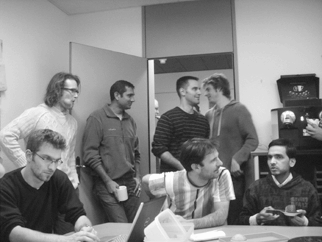

3G cylindrical dendrimer fun
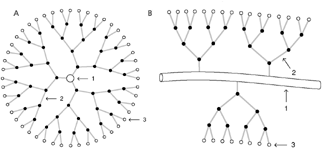
A: Spherical dendrimers (with core 1, side dendrons 2, and terminal groups 3 ) are isotropic, perfectly monodisperse, non-draining nanoscale particles.
B: Cylindrical dendrimers (with backbone 1, side dendrons 2, and terminal groups 3 ) demonstrate anisotropy of the selected axis, with properties depending not only on the generation number, but also on the polymerization degree.
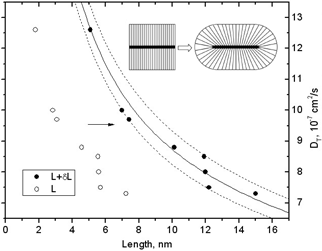
A spherocylindrical model is used to fit the translational diffusion coefficient DT plotted against the mean length of dendrimers. Analysis of the fitting parameters shows that the particles are significantly longer than their backbones, thus suggesting that the sterical repulsion between side dendrons leads to their preferential orientation along the backbone.
Ошибки и научно-технический язык
Вопрос о природе ошибок волнует исследователей уже давно (см., например, обзор [1]). В настоящей работе мы изучаем частный случай — ошибки в научно-технических текстах, написанных специалистами разного профиля на родном и иностранном языках, даем количественные характеристики основных типов ошибок и обсуждаем возможные пути повышения качества обучения.
У специалистов-нефилологов, изучающих иностранные языки в целях профессиональной коммуникации, нет времени на изучение грамматики в полном объеме. С другой стороны, и филологам не удается избежать ошибок в технических переводах. Полностью исключить ошибки нельзя, можно лишь уменьшить их число до разумного уровня: даже лучшее зеркало не является идеально ровным, просто его неровности меньше хорошо известного в физике предела (мы говорим не о смысловых ошибках, недопустимых в техническом тексте, а только о языковых). Кроме того, в техническом переводе заведомо невозможно выучить все тонкости заранее, и здесь важны не только достигнутый уровень, но и способность к решению новых задач. Уточним, что речь идет не о подготовке малого количества специалистов высшего класса, а об обеспечении массовой потребности.
Мы исследовали письменные работы студентов — физиков и математиков, изучающих французский язык, а также студентов, изучающих курс научно-технического перевода. Качественный результат формулируется просто: ошибки в основном однообразны, а их большинство, если посмотреть внимательно, можно было вообще не делать; они не имеют прямого отношения к уровню владения языком и отражают скорее недостаток общей культуры. Подкрепим этот вывод результатами полуколичественных исследований.
[1] А. Б. Шевнин. Эрратология и межъязыковая коммуникация. Вестник ВГУ, Серия «Лингвистика и межкультурная коммуникация», 2004, № 2, с. 36—44
(Из статьи «Анализ ошибок при изучении иностранного языка как языка профессиональной коммуникации», соавт. Д. А. Лисаченко, И. И. Кравченко, М. Е. Соркина, 2006 г.)
Не знаешь конструкции, не трогай
Жил да был робот Вася. Робот он был статный, удалый, смышлёный. Только одна у него беда: на самом носу большущая гайка.
Думал Вася: «Что же делать с гайкой? Совсем она некрасивая, совсем меня портит». Думал-думал и решил: «Надо гайку отвинтить».
Отвинтил, да развалился на части. Мораль: не знаешь конструкции, не трогай!
(Сказка про робота Васю // Красносельский вестник, лето 1997 г., текст восстановлен)
Modelling the foam evolution
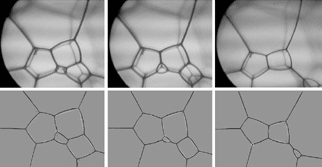
A small computer program simlates the evolution of foam’s spatial structure over time and produces visual output easy to be compared with microscopic videos. The used algorithms rely on simple physical concepts, namely the relation between the radius of curvature of a bubble wall and the difference of pressures, the mutual sliding of bubble walls and the drifting diffusion rates. The elastic processes, breakages and splitting of walls are considered. The internal bubble pressure is proportional to the amount of gas inside bubble and inversely proportional to the volume of the bubble (surface in 2D case.) The program calculates the flux of gas which is proportional to the difference of pressures and to the wall surface (length in 2D case.)
(From Internal structure and elastic properties of aqueous foams evolving in time: a computer simulation,
microscopic photography and acoustic study, with Dmitry Martchenko, Nov. 2006)
Википедия в помощь
Википедия позволяет легко перемещаться между статьями, написанными на разных языках, но посвященных одному и тому же понятию, объекту или явлению. Принцип работы межъязыковых interwiki-ссылок оказывается аналогичен терминологическому словарю (читатель сравнивает названия статей и узнает перевод термина на другой язык).
У interwiki есть существенные преимущества по сравнению с бумажными или электронными словарями. Например, они позволяют перемещаться между любой парой языков (а существуют ли, например, белорусско-французские словари?) То, что interwiki могут позволить узнать переводы важных неологизмов или узкоспециальных терминов, даже не обсуждается.
Однако, по мнению автора, основной, еще не до конца раскрытый, потенциал interwiki состоит в том, что привязка одной статьи к другой (корректный перевод названия) не берётся из словаря, а обдумывается и перепроверяется многими людьми в течение долгого времени.
Пример. Как перевести с русского на английский слово «скорость»? Словарь подскажет: speed или velocity. Однако какое из двух слов нужно использовать в статье по физике?
Оказывается, что speed и velocity имеют очень тонкую разницу в смыслах, которая не всегда отражается в словарях (часто даже узкоспециальных!), однако играет принципиально важную роль. Speed — это «модуль» или «величина» скорости, скалярная величина (см. speed of light, speed of sound). Velocity — скорость как векторная величина.
Эквивалентами в польском языке могут быть слова prędkość (скорость как вектор) и szybkość (скорость как скаляр). Во французском языке существуют термины vitesse, vecteur-vitesse и célérité, которые также имеют существенные, но не очевидные из словаря, отличия по смыслу. Можно привести много примеров такого рода в разных языках. Опыт показывает, что многие дву- или многоязычные словари редко позволяют осмысленно выбрать из нескольких вариантов перевода требуемый. Нужен дальнейший поиск, который требует времени и сил.
(Из статьи «Многоязычная Википедия: языковой помощник для физика и научно-технического переводчика», 2007 г.)
Statistical physics to describe languages
In recent years, many statistical theories and numerical methods have successfully been used to
explain different aspects of human languages such as competition and natural selection [1], extinction
rate [2], sharp transition in vocabularies [3], resemblance to Hamiltonian mechanics leading to
universality of Zipf's constant or growth of children's vocabulary with time [4].
In this paper we demonstrate analogies between physical models describing canonical ensembles
in classical statistical physics and empirical laws established for structure and behavior of human
languages.
In physics, temperature corresponds to the measure of the average energy of the particles in a
system and is an intensive property of this system (not depends on the system size or the mass within).
We define linguistic temperature of a human as a value corresponding to the average skills of a
certain human to speak, write and use largest possible vocabulary. Thus, l.t. is an intensive property of
a human being.
In physics, energy of a particle is generally understood as "the potential for causing changes".
Analogically, we define linguistic energy of a word as its effectiveness in expressing special needs.
Thus, the words ‘to make’ or ‘to drink’ being more frequent, have lower energy than the words 'to
conjugate’ or ‘to substitute’.
Distribution function for the fractional number of usages Ni /N of

where kB is a constant, T is temperature (assumed to be understood in linguistic meaning), gi is the
degeneracy, or number of states having linguistic energy Ei , N is the total number of words in produced
speech or text, and Z(T) is the partition function equal to:

Such analogy leads to important quantative and qualitative results that seem to be in good
agreement with Zipf-Mandelbrot’s law (that states that the frequency of any word is roughly inversely
proportional to its rank in the frequency table), with fluctuation theory that explains why loan words,
slang or neologisms show low linguistic energy for short time but quickly become useless and/or neutral.
Despite the preliminary character of obtained results and dependences, the approach to the human language as to the canonical ensemble of words leads to simple explanation of experimental facts that could be treated only qualitatively before. These observations encourage to study analogies with the virial theorem, quantum statistics and continuity law.
[1] Schulze, C., D. Stauffer. Computer simulation of language competition by physicists (2006), arXiv:physics/0603215
[2] Abrams D.M., S. H. Strogatz. Modelling the dynamics of language death. Nature 424, 900 (2003)
[3] Baronchelli, A. et al. Sharp transition towards shared vocabularies in multi-agent systems (2005), arXiv:physics/0509075
[4] Kosmidis, K., A. Kalampokis and P. Argyrakis. Statistical mechanical approach to human language. Physica A, 366, 495-502 (2006).
(From Methods of statistical physics used to describe the internal structure of human languages:
simple models, analogies and discussion, Nov. 2006)
Экспэдыцыя на ровары ў Мурагі
Ян Баршчэўскі — польскі й беларускі пісьменьнік ды лірык — нарадзіўся на беразе возера Нешчарда ў вёсцы Мурагі Полацкага павету напрыканцы XVIII стагодзьдзя. Ён вучыўся ў Полацку ў езуіцкай калегіі ды заўсёды пісаў у першую чаргу па-польску. У Баршчэўскага было вельмі моцнае чуцьцё да тых народных гаворак, на якіх размаўлялі „w północnej i dzikiej stronie Białorusi“, дзе прайшлі яго маладыя гады й дзе ён заўсёды спыняўся, калі вандраваў па навакольлях.
„Szlachcic Zawalnia, czyli Białoruś w fantastycznych opowiadaniach“ [1] — гэта крыніца фальклярыстычных ды гістарычных зьвестак, збор страшных апавяданьняў, нарысаў пра мясцовых жыхароў, пра Полацак, пра возера Нешчарда і ўсе блізкія мясьціны. Большая частка тэксту — па-польску, але вершы й некаторыя дыялёгі напісаныя па-беларуску лацінкай.
Да Мурагоў здарылася патрапіць на ровары, зь боку Полацку, там дзе аніякая машына ня пройдзе. Там, ў лесу, растуць незабудкі, ляжаць каменьня, расьце мох ды дзікія кветкі, стаяць ёлкі, цячэ рэчка, ў якой ляжыць разбураны драўляны мост. Лётае старажытнае таямнічае паветра. :-)
Бяз дачнікаў, можна лічыць, што ў вёсцы цяпер жывуць толькі тры асобы. «Сваімі запісамі падчас вандроўкі наш слухач падзяліўся з рэдакцыяй. У сёньняшняй перадачы мы хочам наблізіць радзіму Яна Баршчэўскага, сучасную вёску Мурагі. [...] Наш слухач кажа, што апавяданьні Баршчэўскага асабліва цікавымі становяцца на яго радзіме, у ваколіцах вёскі Мурагі, пра якія пісаў пісьменьнік. Там стаіць помнік Яну Баршчэўскаму, усталяваны ў 1997 годзе», — гаворыць Алёна Пытэль, карэспандэнтка Беларускае службы Польскага радыё для замежжа [2].
Дзякуючы гэтым апавяданьням мясцовых жыхароў ды апiсаньням самога Баршчэўскага, Дзьмітры Вінаходаў «вызначыў тое месца, дзе калiсь стаяла хата бацькi Я. Баршчэўскага, святара Мурагоўскае унiяцкае царквы» [3]. «Праўда, яшчэ ў 90-е гг. XX ст. фалькларысты Вiцебскага унiверсiтэта даведалiся ад мясцовых жыхароў, што Плябань называлi колiсь Завальня. Але iх публiкацыi засталiся незаўважанымi. Улетку 2008 г. мясцiны Я. Баршчэўскага наведаў яшчэ адзiн пецярбургскi аматар творчасцi пiсьменнiка, Iлля Марчанка. Гл. яго нататкi: [спасылка], а таксама [спасылка]», — пiша Miкола Хаўстовiч ў часопiсе «ARCHE Пачатак» [3], ня даючы аднак спасылак на віцебскія паведамленьні.
Стары дзядзя Косьця: «Пан Завальня — быў дзядзька Баршчэўскага. Тада, ў то время, када Баршчэўскi вучыўся ў Пецярбурге, — паяздоў ж ў то время ня было, — й ён й пяшком хадзіў ад Пецярбурга да свайго дзядзькі, да Завальні, да Мурагоў». Дзядзя Косьця распавядае пра Хрысьцiну Шчэмялёву, якая нарадзілася ў 1904 г. ў
вёсцы Цюшкова, недалёка ад Мурагоў, ўбок вёсцы Дудчына: «Хрысьцінай звалася, дык тая помніць, што, дзе папоў дом стаяў, так яна тое месца называла ўсё Завальня. Яна ж няграматная жэншчына, но яна помніць. Я гавару: „Адкуда ж Вы знаеце, што там іменна Завальня?“ А яна гаворыць: „Дык маі радзіцелі звалі то месца Завальнёй, і я так» [2, 4].
Старая цёця Женя: «А я адзін год сяку дровы. Гляджу: нейкія людзі ўтраіх ідуць. А мужчына такі, маіх
верна годаў, тады гаворыць: „А Вы знаеце, дзе жыў гэты Баршчэўскі?“ — „Ну — гавораць — што там жыў, знаю, й ў хаце ягонай была. Ну ня ён ужо жыў, а другі ўжо жыў. Тот дом красівы быў. Як быццам, як ісьці к яму ўжо ў памяшчэньне, так нада высока лезьці. Мы зь бацькам хадзілі — ён мяне за руку — і вёў туды ў хату. [...] А чорт яе, дзе яна дзелася. Можа ў вайну лі што. Мы туды пераяжджалі, дзелалі акопы, хаты нашы туды валаклі — парцізаны — і там мы жылі у тых акопах. Усё перамешалася вот так» [2, 4].
Расейскі дачнік зь Тулы Сяргей ганарыцца, што адкапаў зь месца панскае сядзібы кавалачкі каляровага шклу, чарапкі ды сапраўдную сярэбраную лыжку: «Набрали несколько вёдер черепков, где говорили бабки. Мы за ними — тоже набрали полведра, и буквально два дня назад отдали эти черепки корреспонденту
минской газеты. Там очень интересные остатки — очень старинное стекло, старинная керамика, а больше — ничего. Ложка, настоящая польская ложка!» [2, 4].
А сам Баршчэўскі піша: „Stryj mój Pan Zawalnia, dość zamożny szlachcic na zagrodzie, żył w północnej i dzikiej stronie Białorusi: jego dworek czarujące miał okolice; na północ blisko mieskania, Nieszczordo, ogromne jezioro nakształt odnogi morskiej, kiedy czas wietrzny, to w domu słychać szum wód i widać przez okno, jak fale pokryte pianą podnoszą rybackie łodzie w górę i znowu zrzucają. Na południe niziny zielenią się krzakami łozy, gdzie niegdzie wzgórki zarosłe brzozą i lipą, na zachód szerokie łąki i rzeka bieży od wschodu przerzynając te okolice wpada do Nieszczordy“ [1].
«Цікава, як зазначае Ільля Марчанка, жыхары Мурагоў кажуць не Завальня, як было па-польску, а Завальня» [2]. «Признаться, меня это сильно беспокоит. Я специально выяснял вопрос об ударении в этом слове у нескольких белорусских специалистов, в том числе, у Николая Валентиновича Хаустовича. Все они сказали, что ударение должно быть на „а“. [...] Так что у меня снова возникли сомнения в том, как правильно произносить слово "Завальня". :( », — камэнтуе Дзьмітры Вінаходаў [5].
«На самом деле существует топоним „Завальня“, ассоциируемый с тем местом, где стоял дом отца писателя. Ранее упоминание об этом я встречал только в тезисах доклада Татьяны Бубенько из ВДУ „По следам литературного героя“ (но оно было сделано лишь вскользь) и об этом же со ссылкой на местных жителей мне рассказал Анатолий Максимович Дорофеев. Если записки Ильи будут опубликованы, то будет, на кого ссылаться, поскольку у него это положение оговорено подробно», — гаворыць Вінаходаў [5].
30 лістапада 2009 г. Дзьмітры Вінаходаў паведамляе: «Уж свезло, так свезло. Нашёл-таки Завальню. [...] [Д]анный топоним существует в народной памяти до сих пор [...] и обозначает урочище, на месте которого когда-то находилась деревня, хутор, фольварк или что-то в этом роде. [...] Однако, что же именно находилось в этом месте, было непонятно: на доступных мне подробных картах конца XVIII – середины XIX в. это наименование обнаружить не удалось, в списках населённых пунктов Витебской губернии XIX в. его так же нет. Но в более старых источниках информация отыскалась. После взятия Полоцка войсками Ивана IV многие земли в Полоцком повете были переданы новым владельцам [...]. Так вот, в «Писцовой книге волости Нещерды» и в «Книге Полоцкого повета 7078 (1570) г.» в числе поместий, переданных детям боярским [...], упоминается деревня Завалнево: «За Олексеем Серковым сыном Мормылева, дано ему в его оклад в 250 четьи к Невелскому поместью к 41 чети: дер. Завалнево: 1 дв.; пашни 10 четьи в поле, а в дву потомуж, земля добра, сена по дубровам 30 коп., лесу пашенного 13 дес., а непашенного 22 дес. [...]», — піша і цытуе Дзьмітры Вінаходаў 30 лістапада 2009 г. [6].
[1] Jan Barszczewski. Szlachcic Zawalnia, czyli Białoruś w fantastycznych opowiadaniach. Tomik pierwszy. — Petersburg, 1844. Tomik drugi. – Petersburg, 1845. Tomik trzeci. – Petersburg, 1845.
[2] Гістарычная Радзіма Я. Баршчэўскага — в. Мурагі. Беларуская служба Польскага радыё для замежжа, 16.09.2008
[3] Miкола Хаўстовiч. Творчасць Яна Баршчэўскага вачыма рускага чалавека // ARCHE Пачатак, №4 (79), 2009. — С. 391
[4] Iльля Марчанка. Вандроўкі па Беларусі, дасьледчая экспэдыцыя на ровары ў Мурагі. 21 ліпеня 2008 г.
[5] Дзмітрый Вінаходаў. Питерские (09.09.2008), http://urfinwe.livejournal.com/9066.html
[6] Дзмітрый Вінаходаў. Загадки Барщевского: Завальня (30.11.2009), http://urfinwe.livejournal.com/28179.html#cutid1

Flow, electric birefringence: dendrimers

Linear polymers with dendrons of first and second generations based on L-aspargic acid are studied by the methods of flow birefringence and electric birefringence. Optical, dipole, dynamic, and conformational properties of the macromolecules, as well as contributions to their optical anisotropy due to macroform and microform effects, are investigated.
The polymers are found to possess permanent electric dipole moments and undergo reorientation in external electric and hydrodynamic fields according to large-scale rotation mechanism.
A significant growth in equilibrium rigidity, optical anisotropy, and dipole moment of monomer units is observed when rigid benzamide fragments are introduced into the dendrimers. The backbone conformation of second-generation dendrimers containing such fragments is shown to be well described by generalized wormlike chain model.
(Maxwell and Kerr effects in solutions of macromolecules with dendrons in side groups, with Nikolai Tsvetkov, Larisa Andreeva, Irina Strelina, Tatyana Dmitrieva, Nina Girbasova, Alexander Bilibin. Proc. 4th All-Russian Kargin Conf. (Moscow State Univ., Jan. 29-Feb. 2, 2007), Vol. 3, 65, 2007; arXiv:0905.0153v1)
